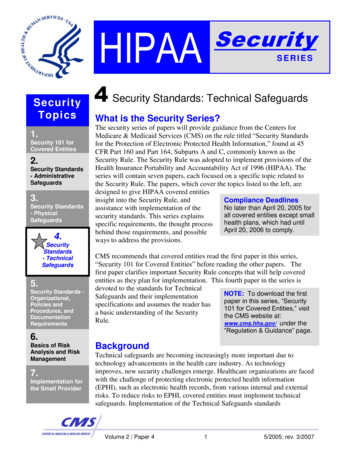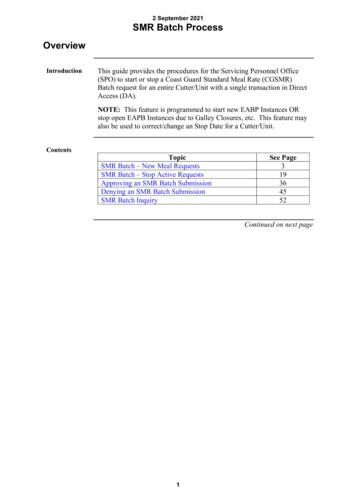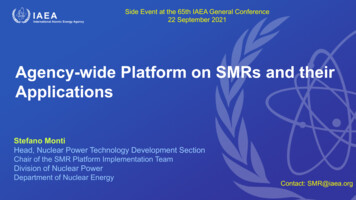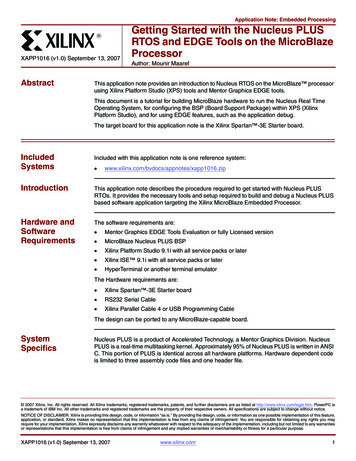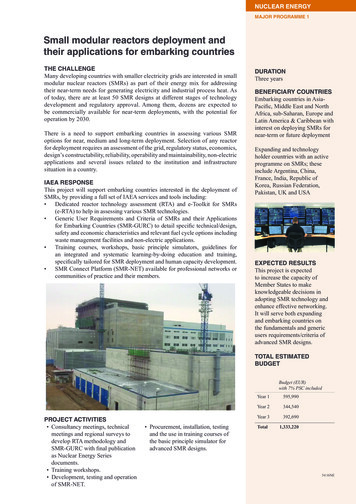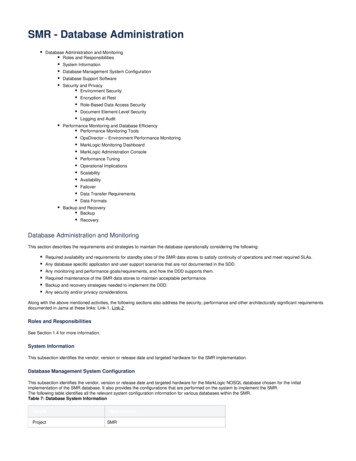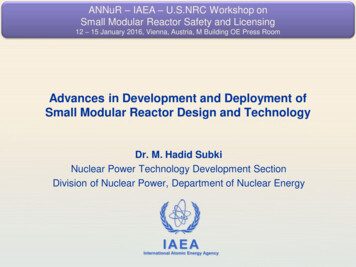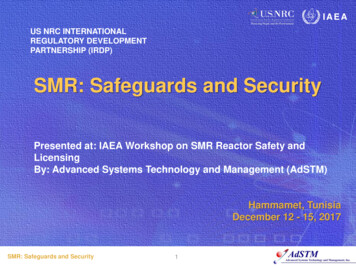
Transcription
US NRC INTERNATIONALREGULATORY DEVELOPMENTPARTNERSHIP (IRDP)SMR: Safeguards and SecurityPresented at: IAEA Workshop on SMR Reactor Safety andLicensingBy: Advanced Systems Technology and Management (AdSTM)Hammamet, TunisiaDecember 12 - 15, 2017SMR: Safeguards and Security1
Outline Safeguards and Security Concepts Overview of U.S. NRC Safeguards and SecurityRegulatory Framework NRC Staff’s position on Safeguards and Securitywith regard to SMRs NEI Position on Physical Security of SMRsSMR: Safeguards and Security2
Introduction Safeguards and security refers to programs thatpromote the common defense and security andprotect public health and safety by guarding againstsabotage, deceit, and theft Safeguards and security are ensured byimplementing Material control and accounting systems and physicalprotection (or security) programs Physical protection of materials and facilitiesSMR: Safeguards and Security3
NRC Security RegulatoryFramework NRC applicants and licensees are required to submitPhysical Protection, Safeguards Contingency, andTraining and Qualification Plans for approval withlicense applications 10 CFR Part 73, “Physical Protection of Plants andMaterials”, establishes the security performance andprescriptive requirements, including the preparationand submission of a physical security plan, atraining and qualification plan, security contingencyplans, and a cyber security plan for nuclear powerreactorsSMR: Safeguards and Security4
NRC Security RegulatoryFramework The Nuclear Non-Proliferation Treaty, U.S. – IAEASafeguards Agreement, Additional Protocol to theSafeguards Agreement (AP), and other internationaland bilateral treaties and agreements place nuclearnon-proliferation obligations on the U.S. government 10 CFR Part 74, “Material Control and Accounting ofSpecial Nuclear Material,” establishes requirementsfor nuclear materials control and accounting (MC&A) A Fundamental Nuclear Material Control (FNMC) Planto possess and use more than one effective kilogramof special nuclear materialSMR: Safeguards and Security5
Material Control andAccounting Material control entails control and monitoringmeasures to prevent or detect loss when it occurs orsoon afterward Material accounting is defined as the use ofstatistical and accounting measures to maintainknowledge of the quantities of SNM present in eacharea of a facility. It includes the use of physicalinventories and material balances to verify thepresence of material or to detect the loss of materialafter it occurs, in particular, through theft by one ormore insidersSMR: Safeguards and Security6
Nuclear Materials Managementand Safeguards System (NMMSS) The U.S. Government has voluntarily entered aSafeguards Agreement with the International AtomicEnergy Agency (IAEA) Maintaining a national system of accounting forsource and special nuclear materials - NuclearMaterials Management and Safeguards System(NMMSS) NMMSS contains current and historical data oninventories and transactions involving source andspecial nuclear materials within the U.S. and on allexports and imports of that material.SMR: Safeguards and Security7
Nuclear Materials Managementand Safeguards System(NMMSS) Safeguards is not a major cost issue forSMRs Issues related to new fuel configurations andfuel handling methods will have to beaddressed for MC&A on a design-specificbasisSMR: Safeguards and Security8
Physical Security Nuclear facilities include nuclear reactors, fuel cyclefacilities, and spent fuel storage and disposalfacilities NRC and its licensees use a graded approach forphysical protection Physical security consists of measures to protectnuclear facilities and material against sabotage,theft, diversion, and other malicious actsSMR: Safeguards and Security9
Key Features of PhysicalSecurity Programs Threat Assessment to determine how muchphysical protection is enough Physical Protection Areas graded to providedefense-in-depth with barriers and controls for theExclusion Area, Protected Area, Vital Area, andMaterial Access Area Intrusion Detection to notify the site's security forceof a potential intruder Intrusion Alarm Assessment to distinguish betweenfalse or nuisance alarms and actual intrusions and toinitiate responseSMR: Safeguards and Security10
Key Features of PhysicalSecurity Programs Armed Response to an intrusion or attack Ongoing NRC regulatory initiatives to maintain theadequacy of NRC regulatory framework in achanging threat environmentSMR: Safeguards and Security11
Safeguards and Security forSMRs Safeguards and Security was identified by NRC staffas one of potential policy, licensing and keytechnical issues in SECY-10-0034 NRC staff assessed adequacy of the current securityregulatory framework and resolved the issue (SECY11-0184) NEI Position Paper, “Physical Security for SmallModular Reactors,” July 31, 2012 NEI White Paper, “Proposed Consequence-BasedPhysical Security Framework for Small ModularReactors and Other New Technologies,” November2015SMR: Safeguards and Security12
SECY-11-0184 SECY-11-0184 summarizes NRC staff’s assessmentof the current security regulatory framework forlicensing SMRs The Staff reviewed the current NRC safeguards andsecurity regulations, relevant Commission ordersand guidance with regard to design and licensing ofi-PWRs and non-LWRsSMR: Safeguards and Security13
SECY-11-0184 The Staff’s conclusions and observations: The current security regulatory framework is adequate androbust The security and material control and accounting (MC&A)requirements adequate for iPWRs Alternative measures, exemptions, and license conditionsavailable under the current regulatory framework provideflexibility for addressing specific issues that may arise Integration of security in design has been used in new largeLWRsSMR: Safeguards and Security14
SECY-11-0184 The Staff’s conclusions and observations regardingNon-LWRs The preliminary conclusion is that the current security regulatoryframework is comprehensive and robust All the current regulatory requirements are applicable to non-LWRs The current regulatory framework does not have obvious gaps withrespect to non-LWRsSMR: Safeguards and Security15
NEI Position Paper, July 2012 The current regulations are adequate for near-termdeployment of iPWRs Reduced size of security staffing is vital for theeconomics of deploying SMRs in the U.S. The inherent design and safety characteristics of SMRsand integration of security in design can provide a basisfor reducing the size of the required security staff Recommends developing a realistic, performance-basedsecurity planning basis for alternative measures and/orexemptions under the current regulatory framework.SMR: Safeguards and Security16
NEI White Paper,November 2015 Suggest addressing SMR security issues throughrulemaking (vs. exemptions, alternative measures, andlicense conditions) Propose a consequence-based physical securityframework Physical security would be ensured primarily byengineered security features without reliance oninterdiction or neutralization of the threat by the onsitesecurity response force Onsite security staff would be required to detect, assessand communicate the threat to offsite respondersSMR: Safeguards and Security17
SMR: Safeguards and Security 17 NEI White Paper, November 2015 Suggest addressing SMR security issues through rulemaking (vs. exemptions, alternative measures, and license conditions) Propose a consequence-based physical security framework Physical security would be ensured primarily by engineered security features without reliance on

